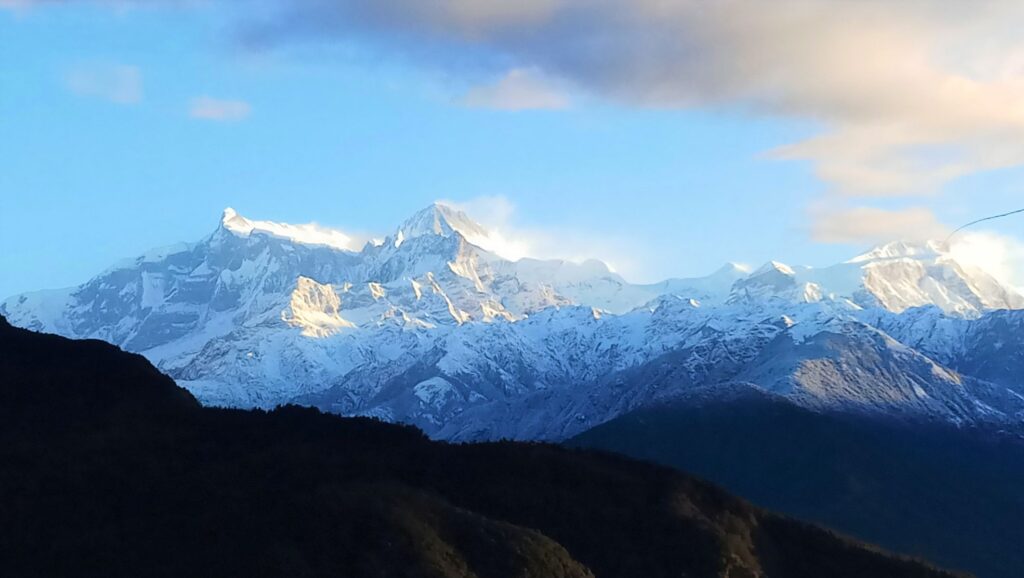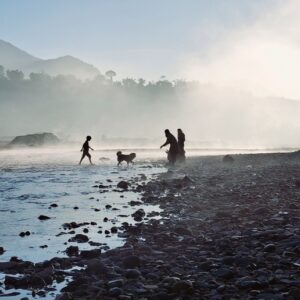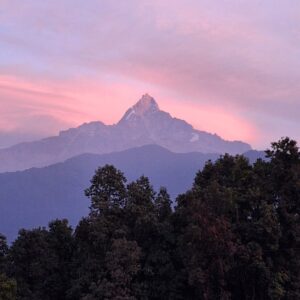
She is a Goddess stirring from her sleep, Earth at her most dramatic.
The Himalaya rose from the deep collision of the Indo-Australian and Eurasian plates, a restless Goddess whose body broke through the skin of the earth some fifty million years ago. Her spine now stretches more than 2400 kilometres across India, Nepal, Bhutan, Tibet and Pakistan, with her arms brushing into Afghanistan and Myanmar. From her glacial breath flow rivers that feed more than 52 million lives.
Her name, born of Sanskrit, Himalaya, means the abode of snow, but she is more than her white crown. Beneath her calm lies constant movement. She rises still, a centimetre each year and in her stiring, her weight shudders in the valleys. When she shifts, earthquakes ripple outward, toppling walls, cracking courtyards, testing the devotion of those who live in her embrace.
She is not still. She never is. She moves, breathes, fractures. She is an unfinished goddess.

A poetic rendition by Dennis Spilchuk:
Eons ago in the planet’s revolution,
During tectonic plate movement:
The Indian Island Ma moved northward,
Crashing into the Eurasion continent,
To form the Himalayan mountains
Out of the chaos, towering peaks arose,
Piercing heavenly soft, white cotton clouds,
Bursting into clear blue skies as Earth revolved,
And orbited the sun in the cosmos;
With Mt. Everest, the highest above sea level.
Nature’s wondrous elevation to behold,
Of precipices, passes and summits,
Overhead fly, Demoiselle cranes and Bar-headed geese,
North to breeding sites in China and Mongolia,
And South to wintering grounds in Tibet and India.
From here, glaciers melt and mountain springs flow,
Functioning as a water tower for millions of people;
And the source to Asia’s greatest, sacred rivers.
Monsoon trade winds strike the westward side,
While the ‘Rain Shadow’ engulfs the Tibetan Plateau.
In this ‘abode of snow’ elusive leopards stalk,
Eking out survival on the lower slopes and cols,
On crags, crests and ledges,
Even toed ungulates, tahrs and goral inhabit;
While Griffin soar, scavenging for fallen victims.
Notes:
1. India was still a part of the supercontinent called Gondwana some 200 million years ago. The Gondwana was composed of modern South America, Africa, Antarctica, and Australia. When this supercontinent split up, a tectonic plate composed of India and modern Madagascar started to drift away.
2. Himalaya: meaning ‘abode of snow.’ Derived from the Sanskrit language which is one of the 22 official languages of India. (Hima-snow, alaya-dwelling) .
3. Mt. Everest (Sagarmatha in Nepali or Chomolungma in Tibetan) : Named after Sir George Everest (1830 to 1843) , a British surveyor and geographer. Mt. Everest is the highest peak on earth above sea level at 8,848 meters (29,029 feet)
4. Bar-headed goose and the Demoiselle Crane: highest flying birds in the world. Both birds are able to fly over the Himalayas at 29,000 feet; surpassed only by the Rüppell’s Vulture of Africa at 37,000 feet.
5. ‘Third Pole’ encompasses the Hindu Kush-Himalaya region and Tibetan Plateau. The Himalayas hold the largest concentration of ice and glaciers (fresh water) outside the Northern and Southern poles.
6. India: Ganges, Indus & Brahmaputra Rivers; South East Asia: Irrawaddy, Mekong and Salween Rivers; China: Yellow & Yangtze Rivers.
7. Westward side of the mountain is the upwind side facing the prevailing winds – tends to get heavy precipitation. Leeward side of the mountain is downwind and is protected and is usually warmer and drier. Also, referred to as the ‘Rain Shadow.’
8. Tibetan (Himalayan) Plateau: ‘Roof of the World, ‘ is the highest elevation plateau in the world.
9. Ungulate: refers to any animal with hooves (a hoof is an enlarged toenail). Tahrs and Goral are species of mountain goats.
10. Griffon (Himalayan) Vulture: Old word vulture feeding exclusively on carrion.
The clouded white peaks have long inspired myriads of tales and legends across the Himalayan people and this itches for another curious narrative in the future.

Photo taken from Astam Village Lodge. Winter 2020.



iiling@cloudsontour.com
11 Jul 2020Me too!
Radhika Acharya
1 Jul 2020Although we ‘studied’ about the Himalayas in school, I learnt a lot from this post!!